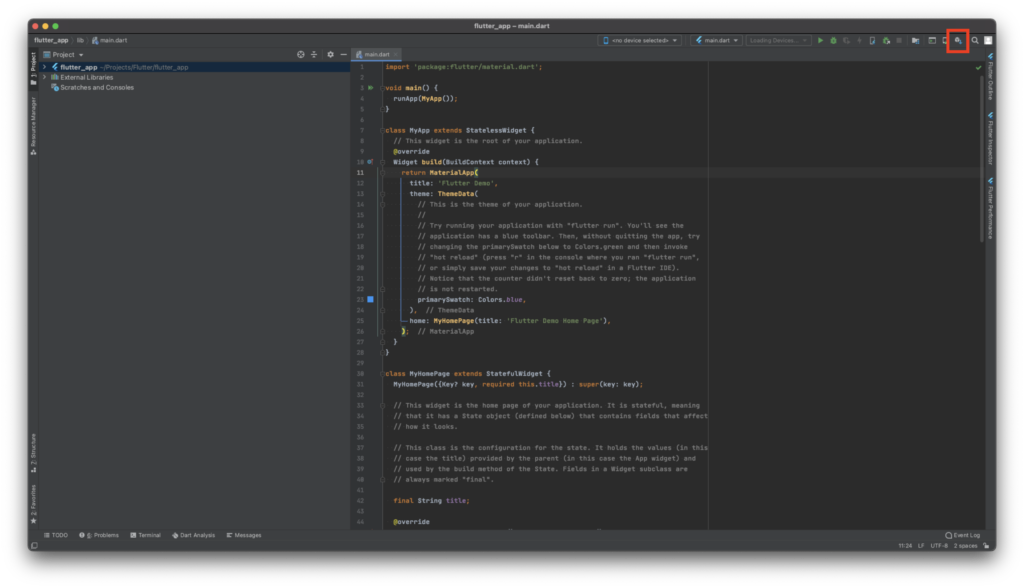
- Flutter for mac m1 install#
- Flutter for mac m1 code#
- Flutter for mac m1 simulator#
- Flutter for mac m1 download#
This will analyze your flutter setup and inform you of any problems. Go back to your terminal window and type in the command ‘Flutter Doctor’. Now, to make sure you have a working flutter install. You can find more info about it Flutter documentation’s Set up an editor section.
Flutter for mac m1 install#
You will also need to install the Flutter and dart plugins on Android Studio. If in case, you want to try out Android Studio for Flutter app development. Once you have installed the flutter and dart extensions you are ready to go with developing Flutter apps with Visual Studio Code. By installing Flutter, you’ll also install the Dart extension. Click the extension button and search for Flutter.

At this point, you need to install the Flutter extension.
Flutter for mac m1 download#
Click on the Download Mac Universal button. Last but not least is Visual Studio code. It will take a moment, but the emulator will launch. To launch it, click the play button in your AVD dialog. Once you are done, give it a name then click Finish. Keep in mind, you can create many different emulators. With the dialog open, click the Create Virtual Device button.
Flutter for mac m1 code#
The result is your code should run like it is on a device with the downsides of it being slower.

Flutter for mac m1 simulator#
Whereas a simulator tries to simulate a device environment, an emulator will emulate the calls and is complete imitation of the real device. This is where you can create different emulators. The AVD is your Android Virtual Device manager. Rather, click the More Actions button and select the AVD Manager option. It may take some time, but once you have it installed, start up the app. I already have it installed, but run through the installation. It also makes for an alternative to developing Flutter apps.ĭownload and install Android Studio. Android Studio is a powerful developer environment. Click the button that reads, “Download Android Studio”. When in question, always trust the device. It’s rare for this to happen but its does happen. This means things may work well on the simulator but may not work on a device. Just a note, the simulator simulates a device environment. Click that and it will launch the simulator. Hover over it and you’ll see a simulator option. If you click the Xcode button, select the Open Developer Tool option. You may be prompted to install additional components. Once you have Xcode downloaded, open it up. Note, you don’t need an Apple developer account to run apps on a device, but if you plan on doing any distributing, you will need such an account. It will take awhile for Xcode to download. It seems like a pain to do all that work on the command line, but the command line provides a bunch of additional tools like Flutter doctor. Now to verify that you have Flutter installed, type the following: which flutterīelieve it or not, that was the hard part. Now refresh the terminal by typing the following command: source $HOME/.zshrc Once you the file editor opens, add the following line using the path that you previously copied: export PATH="$PATH:/Users/brian/Flutter/bin" See the docs if you are still using bash. Since I’m using the latest version of macOS, I’m using the Z-Shell. Now type the following to edit your terminal session.: nano $HOME/.zshrc In the terminal, type the following command: pwdĬopy the path. First, right click your Flutter folder in finder, and choose New Terminal at Folder. Okay, so you have Flutter added to your system, but you need to be able to access it by way of the terminal. Using finder, move the Flutter folder to your home directory. Now, the documents would have you leave the framework in your downloads directory, but I tend to purge my downloads directory after a few months.

Now, find the location of the flutter download. Start by downloading the stable version of flutter by clicking the blue button. Now at the time you are watching this, some of the instructions may have changed so if you run into any inconsistencies following along, defer to the written instructions. Now you’ll see a rather lengthy list of instructions.

Click on the blue button that says Get Started. The first thing you do is open your browser, and head on over to the Flutter development center. We’re going to install Flutter on a macOS. In summation, you’ll need to have the Rosetta 2 translation environment available. If you are using an M1 see the additional instructions linked in the author notes. Also, at the time of this recording, I’m using an intel mac. We’ll also need to setup up our emulators and simulators. Of course, in order for you to build apps, you’ll need the tooling for both iOS and Android as well as the Flutter framework. With it, you can build applications for iOS and Android as well as web applications. MacOS makes for an ideal environment for developing Flutter applications.


 0 kommentar(er)
0 kommentar(er)
